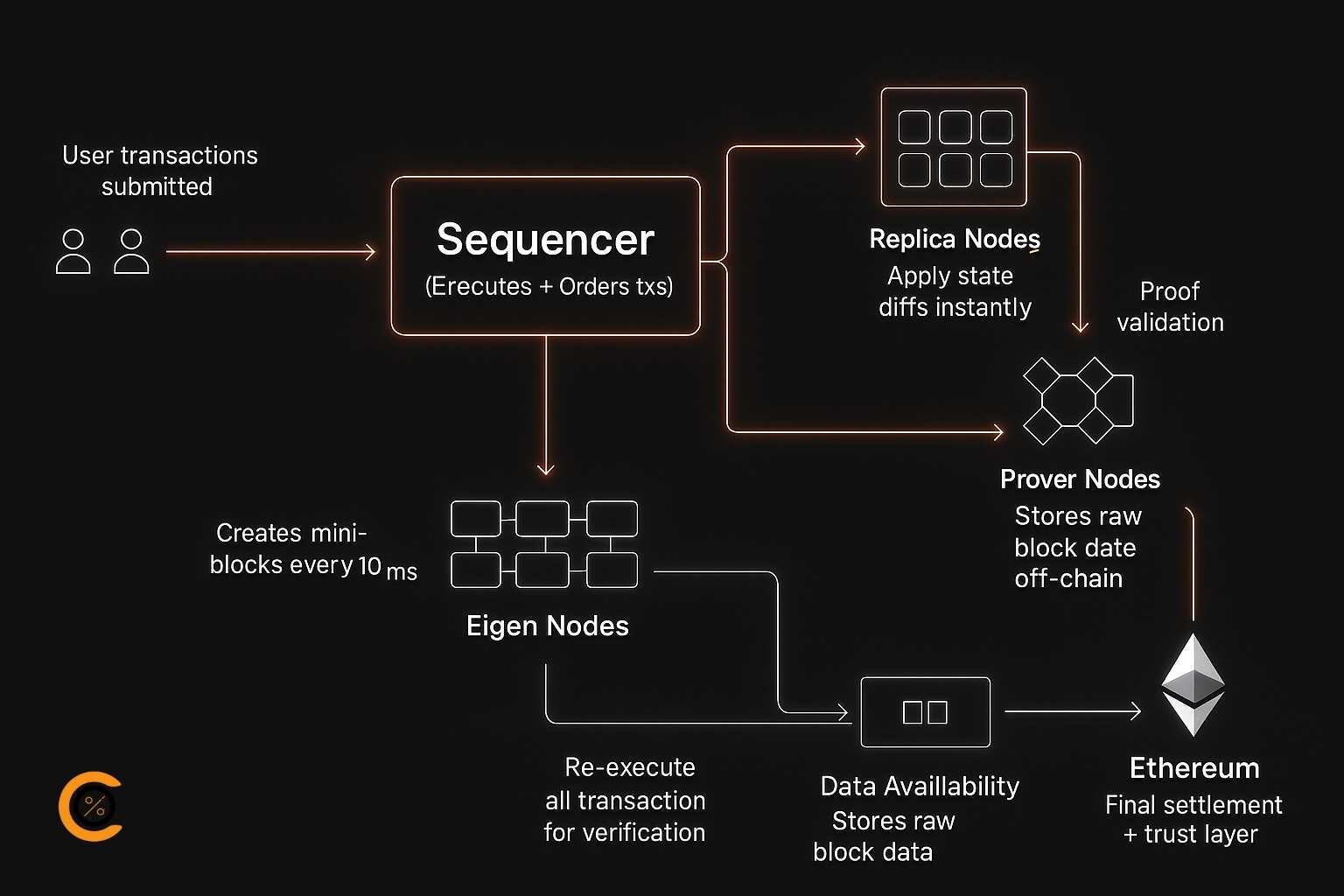- •MegaETH aims to deliver millisecond-level performance using a real-time Layer 2 architecture on Ethereum.
- •The project introduces node specialization and mini-blocks to reduce latency and improve scalability.
- •Backed by Vitalik Buterin, MegaETH tests Ethereum’s speed limits without abandoning its trust model.
The idea behind MegaETH real-time blockchain can be traced back to a 2021 blog post by Ethereum’s co-founder Vitalik Buterin. In that piece, he explored whether a semi-centralized chain could still remain “acceptably trustless” under the right conditions. That idea resonated with two computer scientists, Yilong Li from Stanford and Lei Yang from MIT, who would later turn it into what we now know as MegaETH.
On paper, MegaETH looks like another Layer 2 joining Ethereum’s crowded field, yet it quietly asks a bigger question: is it really just another one? While an article might not be enough to unpack the depth of its research and engineering, we will try to understand what MegaETH is and how this new Layer 2 introduces a fresh way of addressing Ethereum’s long-standing performance limits.
The Origin Story Behind MegaETH Real-Time Blockchain
The MegaETH project grew out of a simple observation. Despite all the progress with Layer 2 rollups and sidechains, blockchain systems still feel slow when compared with ordinary Web2 applications. Even the fastest L2 networks take seconds to confirm a transaction, which breaks the illusion of real-time interactivity. The founders of MegaETH wanted to know if that gap could be closed, not by replacing Ethereum, but by rethinking how its computation layer works.
Ethereum’s architecture, with its emphasis on decentralization and safety, inevitably trades off speed. MegaETH takes the opposite approach. It focuses on performance first and delegates most of the security to Ethereum and EigenLayer, which together act as its trust base. The aim is not to make a new blockchain for speculation, but a testbed for what happens when latency becomes the main design constraint.
How MegaETH Works
To achieve millisecond-level speed, MegaETH changes how nodes share work. Most blockchains ask every node to do everything, including reaching consensus, executing transactions, and storing data. That redundancy adds resilience but slows the system down. MegaETH divides those roles across four specialized node types: sequencers, replica nodes, provers, and full nodes.
The sequencer is the heart of the system. It receives transactions from users, orders them instantly, and executes them in near real time. Replica nodes apply the resulting state changes, called diffs, without running the full transaction logic again. Prover nodes generate cryptographic proofs showing that the sequencer’s work was correct, and full nodes perform complete re-execution for independent verification.
Unlike other L2s that rotate or distribute sequencing among many actors, MegaETH runs a single active sequencer. This decision eliminates coordination overhead and allows the network to achieve sub-second finality. The trade-off is that the sequencer becomes a central point of control. The team argues that trustlessness remains because full and prover nodes can always verify the sequencer’s output.
Understanding MegaETH in Simple Terms
Think of MegaETH like an airport control system. In a normal blockchain, every pilot, tower, and airline would try to manage all flights together. They would constantly talk, recheck routes, and confirm landings before anyone moves. That would make flying painfully slow.
MegaETH fixes that by assigning clear roles. The sequencer acts as air traffic control, deciding which plane (or transaction) goes first. Replica nodes are like screens at every terminal, showing live updates of flight changes without re-checking every route. Prover nodes work like auditors who double-check that flights landed where they were supposed to, while full nodes replay the entire journey for complete verification.
Because of this division, planes can land every few seconds instead of every few minutes. That’s what “real-time blockchain” means in MegaETH—transactions flow smoothly like coordinated air traffic instead of waiting for every pilot to approve each landing.
The Mini-Block System in MegaETH
Another defining feature is the concept of mini-blocks. Instead of batching thousands of transactions into a block every few seconds, MegaETH generates lightweight mini-blocks roughly every ten milliseconds. These are streamed across the network like live updates, while traditional EVM blocks are still produced once per second for compatibility. This hybrid model preserves the EVM ecosystem while giving developers something that feels instantaneous.
For data availability, MegaETH uses EigenDA, an external layer built on EigenLayer. EigenDA stores raw block data, freeing Ethereum from the burden of heavy transaction storage. Ethereum still handles final settlement, meaning all proofs that confirm correctness are anchored back to its mainnet, but the actual data is stored off-chain for speed. It is a modular design that mirrors Ethereum’s current shift toward rollup-centric scaling.
The Hardware Powering MegaETH Real-Time Blockchain
Running a system like this takes serious hardware. According to MegaETH’s technical documentation, a sequencer node could require up to 100 CPU cores, 1 to 4 terabytes of memory, and 10-gigabit network bandwidth. This pushes the performance envelope but also makes sequencing an expensive role. Other node types are lighter. Replica nodes may run on consumer-grade setups, while prover nodes can operate efficiently with minimal CPU power.
The design reflects a simple idea: not every node must do everything equally. High-performance servers can handle transaction execution, while cheaper machines maintain verification and redundancy. This hierarchy is controversial in blockchain circles, but it is part of the project’s experiment, seeing how far performance can go before decentralization truly breaks down.
MegaETH’s engineers have been open about the technical hurdles. Ethereum’s execution clients, even optimized ones like Reth, face major performance bottlenecks due to how they update the Merkle Patricia Trie, a complex data structure that tracks blockchain state.
The team claims that updating this trie is nearly ten times more costly than executing transactions. Overcoming that required redesigning how state updates propagate, how memory is cached, and how data synchronization is handled in real time.
| Role | CPU | Memory | Network | Notes |
|---|---|---|---|---|
| Sequencer | 100 cores | 1–4 TB | 10 Gbps | High-performance server |
| Full Node | 16 cores | 64 GB | 200 Mbps | For independent validation |
| Replica | 4–8 cores | 16 GB | 100 Mbps | Lightweight participant |
| Prover | 1 core | 0.5 GB | Low | Minimal verification load |
Funding and Development Progress of MegaETH
MegaETH’s development has moved quickly since its seed funding in 2024. That round, worth twenty million dollars, came from Dragonfly Capital, Figment, and Robot Ventures, along with participation from Vitalik Buterin himself. Later that year, a public sale on Echo raised another ten million in just three minutes.
In early 2025, the project launched The Fluffle, a collection of 10,000 non-tradable NFTs tied to its token distribution. The first half sold for one ETH each, bringing in around thirteen million dollars.
The team’s total funding now exceeds forty million, and they have launched a public testnet that developers are using to experiment with low-latency decentralized applications. The mainnet is expected to arrive later in 2025, following a phase of open testing and performance evaluation.
The Design Philosophy Behind MegaETH
MegaETH is built on a philosophy of measurement before optimization. The team often says that many blockchain projects focus on isolated improvements that fail to translate into meaningful gains for users. Instead of minor tweaks, they aim for a clean-slate approach that pushes hardware to its limits. The goal is to reach a point where the bottlenecks are not in software anymore but in the physical hardware itself.
Their reasoning is that once blockchains run as fast as the underlying servers allow, the conversation can shift from infrastructure back to applications. This is why the team describes MegaETH not as a competitor to other chains, but as a research-driven network that tests the upper boundaries of Ethereum-compatible performance.
The Risks and Trade-Offs in MegaETH’s Design
Every performance-oriented design comes with trade-offs, and MegaETH is no exception. The most discussed one is the single sequencer model. Centralization speeds up execution but also creates a single point of failure. If the sequencer goes offline or acts dishonestly, the network may pause until validators intervene.
The reliance on EigenDA introduces another layer of dependency. If EigenDA experiences downtime or loses data, MegaETH’s transaction availability could suffer. There is also the question of hardware accessibility, as the high-end sequencer requirements may limit participation to well-funded operators. Critics argue that this approach could recreate the same centralization issues that blockchains were meant to avoid.
The team acknowledges these risks. Their answer is that validation, not production, defines decentralization. As long as proofs and full node verification remain open, the network stays trustless, even if block creation is handled by a powerful server. It is a bold stance that challenges long-held assumptions in blockchain design.
How MegaETH Compares Among Top Layer 2 Projects
MegaETH arrives at a moment when Layer 2 innovation is moving in many directions. Some teams focus on zero-knowledge rollups, others on modular data layers or custom execution environments. As developers explore top layer 2 projects that push Ethereum’s boundaries, MegaETH stands apart for its willingness to question the traditional balance between speed and decentralization. Rather than optimizing existing code, it rebuilds the model around real-time responsiveness. Whether this approach sets a new precedent or stays a specialized experiment will depend on how the ecosystem responds after launch.
| Chain | TPS (approx.) | Block Time | Architecture | Notable Trait |
|---|---|---|---|---|
| Ethereum L1 | ~15 | 12 sec | Monolithic | Secure but slow |
| Arbitrum One | ~40 | 0.25–1s | Rollup | Fast, scalable |
| opBNB | ~650 | 1s | Optimistic Rollup | High throughput |
| MegaETH | 1M+ (theoretical) | 10ms | Specialized L2 | Real-time processing |
Can MegaETH Deliver True Real-Time Ethereum?
The rise of MegaETH real-time blockchain shows how far Ethereum’s scaling efforts have evolved. The idea that an EVM-compatible chain could run at millisecond speed once sounded unrealistic. Now, it is being tested in public.
Performance claims will soon face the reality of open networks, unpredictable usage, and economic incentives. MegaETH may succeed or struggle, but either outcome will influence how the industry defines scalability. It is not just about speed; it is about testing the limits of what Ethereum can become when performance is pushed to its edge.









